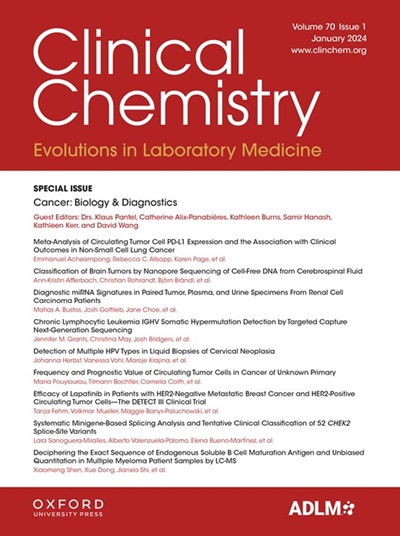A Comprehensive Review of Estradiol, Progesterone, Luteinizing Hormone, and Follicle-Stimulating Hormone in the Context of Laboratory Medicine to Support Women's Health.
IF 7.1
2区 医学
Q1 MEDICAL LABORATORY TECHNOLOGY
引用次数: 0
Abstract
BACKGROUND There have been conflicting messages about the influence of female sex hormones on women's health, with historical messaging indicating that use of estrogen and/or progesterone in peri- or postmenopause poses a significant clinical risk to cisgender women. More recent guidance indicates that the benefit of hormone therapy (HT) outweighs the risks for symptomatic women. Exogenous estrogen use is also indicated for contraception and gender-affirming care. Despite the potential for broad applications, robust reference intervals for estradiol, progesterone, luteinizing hormone (LH) and follicle-stimulating hormone (FSH) are lacking, and guidelines indicate that measurement of 17-β-estradiol (E2), progesterone, LH, or FSH does not facilitate care in women who may be experiencing menopausal symptoms or women taking exogenous HT. CONTENT Here we review the physiological roles of estrogen, progesterone, LH, and FSH. We examine the modes of administration for estrogen and progesterone, clarify the nomenclature related to exogenous hormone use, and comprehensively review the literature for studies evaluating normal concentrations of these female gonadal axis hormones during the menstrual cycle. The content primarily focuses on cisgender women, but some aspects of these hormones in transgender women will also be discussed. SUMMARY Currently, E2, LH, FSH, and progesterone reference intervals for women remain incomplete. Although there are a variety of clinical indications that benefit women using HT, symptoms and shared decision-making should guide care. Collaborative efforts between clinicians and laboratory professionals to better define therapeutic or reference intervals for these hormones can advance women's health globally.雌二醇、黄体酮、促黄体生成素和促卵泡激素在支持妇女健康的实验室医学背景下的综合综述。
背景:关于女性性激素对女性健康的影响,一直存在相互矛盾的信息,历史信息表明,在绝经前后使用雌激素和/或黄体酮对顺性女性有显著的临床风险。最近的指导表明,激素治疗(HT)的好处大于对有症状的妇女的风险。外源性雌激素也用于避孕和性别确认护理。尽管具有广泛应用的潜力,但缺乏雌二醇、黄体酮、黄体生成素(LH)和促卵泡激素(FSH)的可靠参考区间,并且指南指出,17-β-雌二醇(E2)、黄体酮、LH或FSH的测量不能促进可能经历更年期症状或服用外源性激素的妇女的护理。内容综述了雌激素、黄体酮、黄体生成素和卵泡刺激素的生理作用。我们研究了雌激素和黄体酮的给药方式,澄清了与外源激素使用相关的术语,并全面回顾了有关评估月经周期中这些雌性性腺轴激素正常浓度的研究文献。内容主要集中在顺性女性,但这些激素在跨性别女性的一些方面也将讨论。目前,E2、LH、FSH和黄体酮的女性参考区间仍然不完整。虽然有多种临床适应症有利于妇女使用HT,症状和共同决策应指导护理。临床医生和实验室专业人员之间的合作努力,以更好地确定这些激素的治疗或参考间隔,可以促进全球妇女的健康。
本文章由计算机程序翻译,如有差异,请以英文原文为准。
求助全文
约1分钟内获得全文
求助全文
来源期刊

Clinical chemistry
医学-医学实验技术
CiteScore
11.30
自引率
4.30%
发文量
212
审稿时长
1.7 months
期刊介绍:
Clinical Chemistry is a peer-reviewed scientific journal that is the premier publication for the science and practice of clinical laboratory medicine. It was established in 1955 and is associated with the Association for Diagnostics & Laboratory Medicine (ADLM).
The journal focuses on laboratory diagnosis and management of patients, and has expanded to include other clinical laboratory disciplines such as genomics, hematology, microbiology, and toxicology. It also publishes articles relevant to clinical specialties including cardiology, endocrinology, gastroenterology, genetics, immunology, infectious diseases, maternal-fetal medicine, neurology, nutrition, oncology, and pediatrics.
In addition to original research, editorials, and reviews, Clinical Chemistry features recurring sections such as clinical case studies, perspectives, podcasts, and Q&A articles. It has the highest impact factor among journals of clinical chemistry, laboratory medicine, pathology, analytical chemistry, transfusion medicine, and clinical microbiology.
The journal is indexed in databases such as MEDLINE and Web of Science.
 求助内容:
求助内容: 应助结果提醒方式:
应助结果提醒方式:


